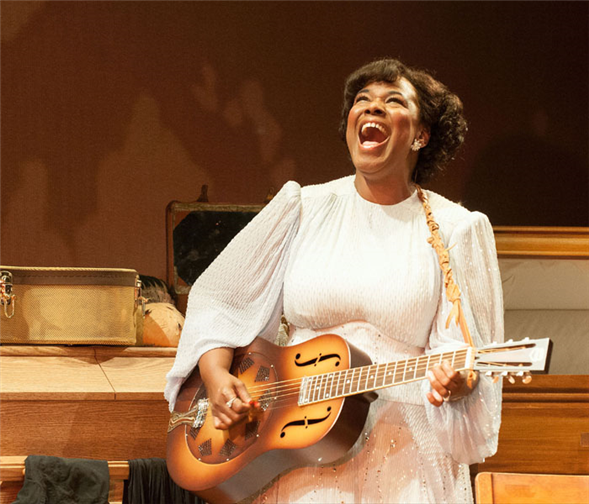Translate Page

Marie and Rosetta knows the soul of a musical legend
---
George Brant could set Marie and Rosetta anywhere. As he recounts both the friendship and artistic genius of musicians Marie Knight and Sister Rosetta Tharpe, he could place them on a tour bus or in a recording studio or backstage at a gig.
Instead, he puts them in a room full of coffins.
That's partially a historical reference. Back in the 1940s, when Sister Rosetta was at the height of her stardom as a gospel singer and guitarist, she played major clubs and posh rooms all over the north. Her thrilling mixture of church music and blues not only made her famous, but also inspired everyone from Elvis to Chuck Berry to Johnny Cash to Little Richard. (She's called "the Godmother of Rock and Roll" for a very good reason.)
In the south, however, Sister Rosetta was at the mercy of Jim Crow. She hired a white bus driver for her tours, so that he could buy the band food, and since she couldn't book a room at most hotels, she relied on the generosity of the African-American community. Sometimes that meant sleeping in a black-owned funeral home, with a coffin for a bed.
That's the situation in Brant's play-with-music, which is now at the Atlantic Theater. During a tour through Mississippi, Sister Rosetta has heard Marie Knight sing, and she's auditioning the young woman there among the caskets to see if they might work together.
Theatrically speaking, though, the setting isn't only a funeral home. Marie and Rosetta had enormous success together and stayed close for decades, even as they endured terrible personal losses. So as they belt gospel songs like "This Train" and "Up Above My Head" in a chamber of death, their resilience is on glorious display. "They're singing this joyful music in the middle of that, and that hopefully resonates with people," says Brant. "They have that ticking clock around them, but they're singing."
{Image1}
And they're singing together. Instead of fighting or jostling for power, Brant has his characters fundamentally support each other as they learn to unite their sounds.
Again, that's partially based in fact. "What amazes me about their recordings together is that Marie is not a backup singer," says Brant, and he's right. Though Sister Rosetta could've demanded a starring role alongside the newcomer she was grooming, she always shared the spotlight.
With that in mind, Brant avoided writing arguments between the two women. "In some ways, I was looking to write a play with as little conflict as possible," he says. "I don't mean I want it to be boring, obviously, but in many ways the play is about generosity. About the generosity these two women have for each other."
That generosity informs the decision to have two female musicians support Kecia Lewis (who plays Rosetta) and Rebecca Naomi Jones (who plays Marie). While the actresses sing, Deah Harriott rocks the piano with juke joint flair and Felicia Collins sizzles on both electric and acoustic guitar. As they make their music, this community extends the legacy of the title characters.
Brant wants it that way. "Part of the impetus for writing the play, really, was feeling that these two people are undersung," he says. "They've contributed an awful lot to our American landscape, and that deserves to be celebrated."
---
TDF Members: At press time, discount tickets were available to Marie and Rosetta. Go here to browse our current offers.
Follow Stages editor Mark Blankenship at @IAmBlankenship. Follow TDF at @TDFNYC.
Photos by Ahron R. Foster. Top photo: Kecia Lewis as Sister Rosetta Tharpe.